VIOLETTE SZABO
George Cross and Croix de Guerre
The publishing of this excerpt on the Internet is with the kind permission and courtesy of Steve Thomlinson who retains the copyright. The actual book was launched on the 23rd. June 2001 at the first ever Violette Szabo GC Picnic at the Violette Szabo GC Museum and it will be available from Rosemary Rigby MBE direct on Tel. 01981-540477.
Steve Thomlinson
Artisan
25, Cleveland Avenue, Stokesley,
North Yorkshire TS9 5EZ
Tel. 01642-710908 - Fax. 01642-440251
We invite you therefore to acquaint yourself with the information contained here and possibly assist with the ongoing running expenses of the Museum by purchasing the book direct from Rosemary or by showing your appreciation of a brave young lady who sadly lost her life in the cause of freedom for millions around the world by making a much needed donation to the
Violette Szabo GC Museum, "Cartref", Tump Lane, Wormelow, Herefordshire HR2 8HN. Tel. 01981-540477.
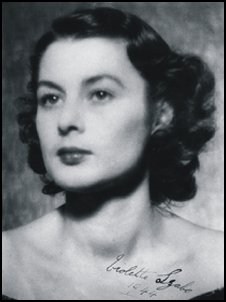
Violette Reine Elizabeth Szabo GC
Introduction by Rosemary Rigby M.B.E.
Founder of the Violette Szabo GC Museum
A dream that became a reality on the 24th June 2000! During the 36 years I have lived at ‘Cartref House’ the idea of creating this unique memorial for Violette took root.
Having already collected many items and received into my care the special collection of Margot Dennis of Eardisley, Hereford, I wanted to go forward to benefit future generations.
The launch of the appeal took place on the 31st October 1998 in pouring rain at Much Dewchurch Village Hall. It was attended by Virginia McKenna, offering her great support to help raise the £ 20,000 needed to complete the project.
At her suggestion, I was later approached by Steve Tomlinson, a designer in North Yorkshire, who was interested in researching and designing the four panels which now hang in the Museum.
The Trustees decided to commission Steve to compile the panels and have been very delighted with his work. Each panel is introduced by the words from ‘Violette’s poem’, "The Life That I Have", written by the S.O.E. Codemaster, Leo Marks.
So, in response to overwhelming requests, we have again contacted Steve and asked him to design this small booklet consisting of his original main text, other extracts and a few new items.
May God continue to bless our venture, The Museum and Violette to watch over it.
Rosemary Rigby MBE
February 2001
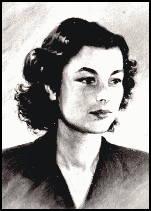
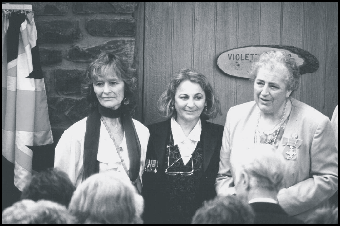
Virginia McKenna, Tania Szabo & Rosemary Rigby MBE
at the Opening Ceremony of the
Violette Szabo GC Museum
24th. June 2000
The Museum is open every Wednesday - April to October and at other times by appointment. Groups by special arrangements only. Please telephone 01981-540477.
This unique museum has received financial contributions from:
- Awards for All (National Lottery)
- Small Projects Fund
- Southern Marches Partnership
- Donations from the people of Herefordshire and across the world
Further donations to assist with the on-going support of the museum would be greatly appreciated.
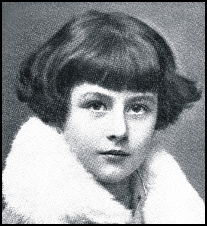
The 'incorrigle tomboy' aged 9,
wearing a fox fur her mother adapted from a coat.
The Life that I have
is all that I have
And the life that I have is yours
In February 1958, the name of Violette Szabó became world famous with the release of a film called 'Carve Her Name With Pride'.
Taking its title from R. J. Minney's biography of her, published two years previously, it is the tragic story of a beautiful, lively and adventurous woman who became a secret agent during the Second World War.
Violette was someone who remained true to not only those she loved, but also to her vivacious, fearless and kind spirit, in times of hardship, amid the dangers of war and when surrounded by atrocity. Her life story sets an example to, and touches the hearts of, each and every generation.
She was born Violette Reine Elizabeth Bushell in Paris on the 26th June 1921, the second child of an English father, Charles, and a French mother Reine Blanche (Leroy). They had met during the First World War and were married at Reine's home village of Pont Rémy, in Northern France, in 1918.
Violette's name was chosen because her eyes were rimmed with violet. Because all Leroy children were named after kings and queens Violette retained her mother's name, which means 'Queen'. The surname Leroy itself is derived from the old french for 'the King'.
Throughout the rest of her life, Violette was imbued with a sense of belonging to both nationalities and would impress everyone she met with her beauty and strength of character.
With innate physical prowess, and growing up with her brothers Roy, John, Noel, Richard and several boy cousins, she became something of an incorrigible tomboy who would always manage to retain a feminine grace.
The Bushells moved between France and England for some years. After finally settling at 18 Burnley Road, Stockwell, London in 1932, the children went to the local school in Stockwell Road. Violette was always well dressed because her mother, who was an excellent seamstress, made all her clothes.
'Vi', as she was known in the family, was a close school friend of Florence Cooper, who remembers Violette as a beautiful girl with shining blue black hair "like a Raven's wing", who spoke with a slight French accent, and would stand and fight to protect her "Florsie" from school bullies.
Teachers said of her that "with those large, lovely eyes, she looked like something not quite of this world", and that "there was no drain pipe she could not climb, no wall she could not scale". Her headmistress, Mrs. Clarke, was aware of her strong will, sense of leadership and how she "vibrated with personality".
Violette often saw, and stayed with, her relations, the Buckinghams. Most summer holidays, until the outbreak of war, were spent at Pont Rémy with her Aunt Marguerite Leroy, who had looked after Violette for most of her first seven years.
Many holidays and periods of time off and convalescence, right up until her last days in England, were spent with her relations, the Lucas's, at 'The Old Kennels' (as 'Cartref' was called then) in Wormelow, Herefordshire. Her Uncle, Harry, (Charles Bushell's brother-in-law), was the South Herefordshire Hunt Wipperin and cared for the hounds.
Violette's cousins Norman, John, Joan, Brenda and Jean went to the local school (now known as The Old School). It was here Violette and her mother got off the bus from Hereford. As they walked down Tump Lane to 'Cartref' neither of them could have imagined in their wildest dreams the impression that Violette was to leave behind and the lasting dedications that would be created to her memory.
At the age of 14 she left school with ambitions towards being a hairdresser, but the cost of her training could not be met. Her first job was as an assistant in a French corsetière in South Kensington, where her knowledge of the language was useful.
During her time off she would cycle, swim and shoot on equal terms with her brothers and male cousins, and was always up to practical jokes.
One terrible day Violette disappeared. The whole family was distraught. They soon realised just how much the 14 year old would do once her mind was set when they were told by the local police that she had been located in France. Knowing she would have been prevented, Violette had secretly taken her passport and visited her 'Tante', (Aunt), Marguerite, who she loved dearly, at Pont Rémy.
She returned after a few weeks and later found work as a sales assistant at Woolworths in Oxford Street.
Meanwhile, she tried to express her love of music through vain attempts at the violin and piano. Eventually, her athleticism enabled her to express that passion through dancing.
She lost her job at Woolworths in 1937. The autumn of that year saw Violette's opportunity to attend her first ball, at the age of 16, at the Savoy Hotel where her brother, Roy, worked. He took his sister to the Staff dance where her beauty and long white satin evening dress, made by her mother, made a great impression.
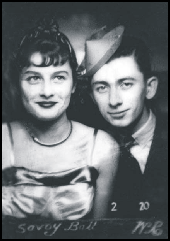
Violette and Roy at the Savoy
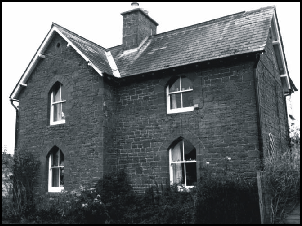
‘Cartref’, Wormelow, Herefordshire, was a house that was very familiar to Violette. It was the former home to her cousins, the Lucas family. Many holidays and happy times were spent there.
Her last visit was shortly before her final mission.
36 years after she became the owner, Rosemary Rigby M.B.E. finally raised the funds to build The Violette Szabó G.C. Museum within the grounds.
'Cartref' was known to Violette and her cousins as 'The Old Kennels'.
The upstairs window on the left was where she slept. She never did anything by half- measures. The glass in her bedroom window once had to be replaced after a pillow fight!
A local schoolboy, George Holly, knew her as a young girl. He remembers that "she was the biggest tomboy you could ever wish to see. She had lovely long black hair down to her shoulders and had a defiant look in her eyes even then."
To their amazement, George and his friend, Elvin, once saw the 'little monkey', then aged about ten, actually running along the ridge of the roof of the Lucas home!
In the middle of the field, next to 'Cartref', where the children played, Violette would climb and swing from the boughs of an oak tree that was once there. She also "taught local children to play rounders and was daring and full of fun" said her cousin Brenda.
Her Aunt, Florence Lucas, once said that Violette "was a beautiful girl who just did not know what danger was. She was always daring, even as a child".
Norman Lucas remembers her showing him how to get into London Zoo through a hole in the fence!
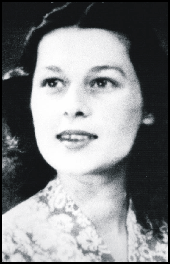
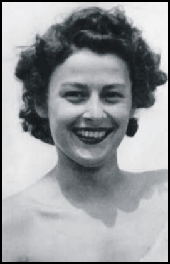
Violette was a keen cyclist and would often stop and talk to Sidney Mathews, who ran his tyre shop in Stockwell Road, when passing. Sidney, who last saw her in her FANY uniform, said of her that " She was a lovely person, full of life and did'nt seem to have a care in the world!"
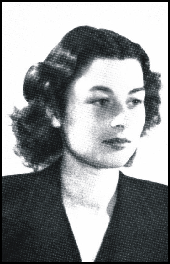
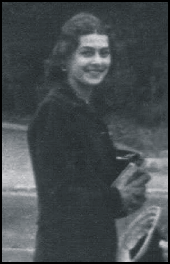
Violette, destined to become one of the most famous heroines of the Second World War
Violette often went dancing with her friend, Winnie, at the Streatham Locarno and The Swan dance hall. They also had fun on Sunday nights at The Empress, Brixton, where they showed movies or held 'amateur nights'.
She was a natural crack shot - to the annoyance of the shooting arcade owners at Hereford Fair and London from whom she won many cigarettes - the usual prize at the time.
Roy Forbes Morgan, a friend of Roy Bushell, remembers how they would all go to the winter fair held at the coach station opposite Lambeth Town Hall: " I watched her on the rifle range and saw her on the dodgems having a laugh. Every time I hear Irving Berlin's 'I've Got My Love To Keep Me Warm', I can see Violette and her friend as they went up in the 'Big Wheel' singing it at the top of their voices!
At the outbreak of War, in the September of 1939, Violette, then aged 18, had taken her four year old brother, 'Dickie', on her annual holiday to Tante Marguerite's. Violette was desperately torn between staying in France with her beloved Aunt and going, but she soon realised that she was duty bound to get her little brother to safety. Thus, they cut short their stay and only just managed to board a boat leaving for England.
The war was to dramatically change the lives of everyone, Violette's especially.
However, it began quietly for her by working as a popular member of staff on the perfume counter at the Bon Marché store in Brixton, where her French was put to good use again. But, with her brothers Roy and John signing up, and the younger ones being sent to the safety of the countryside as the war gained momentum, she began to feel the need to channel her efforts more directly. In the end, she was to contribute more than most.
The following April she left the store to join the Land Army, and picked strawberries at Fareham with her good friend Winnie Wilson.
This period of her life saw her, yet again, standing up for a friend when Winnie was propositioned by a gypsy 'worse for drink'. With her hands on her hips, a defiant look, and a sharp "Leave her alone or I'll let you have it !" the gypsy and his friends, who had been watching, quietly went on their way.
Not long after her 19th birthday, Violette was restless to do something more important, so She returned home with Winnie.
A few days later, on Bastille Day (July 14th), her mother asked her to go to the Cenotaph and invite a French soldier home to celebrate the national holiday.
Winnie accompanied her to Hyde Park where a 30 year old Sergeant Major from the French Foreign Legion, who had attended the Bastille Day parade, spoke to them. He asked the time, then they all laughed when the sight of his watch gave away his pretence!
He was a Hungarian born French National and had been in the Foreign Legion since the age of 15. His name was Étienne Szabó. Szabó is the Hungarian name for Tailor. He was duly invited back to the Bushell family home.
After a whirlwind romance and much to the approval of her parents Violette and Étienne were married on the 21st of August 1940 at Aldershot registry office, near to where his regiment was stationed.
The ceremony was attended by Mr. and Mrs. Bushell and Violette’s eldest brother, Roy. Some of Étienne’s best friends were there, including Étienne Kiss who was best man.
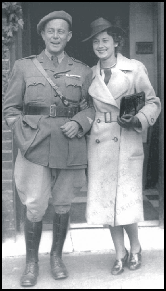
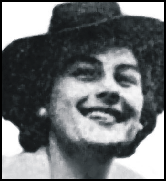
Violette and Etienne on their wedding day and Violette pictured in a newspaper.

Mr. and Mrs. Bushell are standing to Etienne's right. Roy Lucas is behind.
Reine and Etienne. Etienne Kiss, the best man, is on the far right.
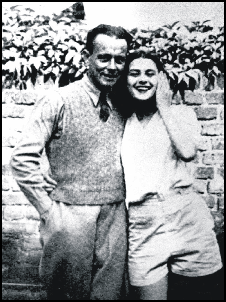
Violette and Etienne in the garden of 18 Burnley Road
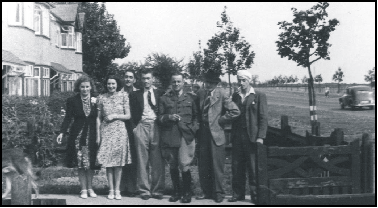
Etienne and Violette's father with the Buckinghams outside their home, Bedford House, Bath Road, Harmondsworth.
Violette probably took this picture which shows (left to right)
Ena (Ron's wife) Violet, John, Charlie, Etienne, Charles Bushell, and Ron.
The love that I have
Of the life that I have
Is yours and yours and yours
After a short honeymoon at a local hotel, Étienne soon had to sail with his regiment to Abyssinia. Although he preferred Violette not to work she became restless. He relented and Violette became a telephonist at an exchange near St. Paul's Cathedral.
Just before the year was out the exchange was bombed, providing Violette and her colleagues with a few weeks off.
Working in the new premises meant sitting on the floor in a cold, damp cellar. Eventually, Violette developed a bad cough and went to stay with the Lucases in Wormelow until she was fit to return.
Luckily, cousin Norman was home on leave from the Navy, which provided a much-loved opportunity to go around the country lanes on the back of his motorbike.
Upon her return home, news came that Étienne was about to embark at Liverpool with a weeks leave before flying out to Cairo. After taking the next available train, Violette and Étienne were together again for a second honeymoon in a nearby luxury hotel.
During that time Étienne consented to her wish to join the Auxillery Territorial Service, (ATS). After they had parted for the second time she joined up on the 11th of September '41.
After initial training she was sent to Leicester (where she had once lived when she was 8).
Although her days consisted of cooking, waitressing and laundry chores she enjoyed the social life in the evenings. But, again she soon became frustrated and yearned for a more active service that suited her - preferably an armed one.
She joined one of the first mixed Ack Ack batteries - No.481(M) in Oswestry, Shropshire, towards the end of October '41. With Étienne always on her mind, she gained permission to wear a Free French flash on the shoulder of her battle dress blouse.
Her Commanding Officer, Lt. Col. Jim Naylor said of his 5'3" Vickers Predictor operator, "She was tiny, very slim and very attractive. Because of her height, or lack of it, she seemed always to stand on her toes when at her instrument.
She was very popular and her officer and NCOs always spoke highly of her as a soldier and as a comrade. She and another girl held French classes in the evenings with excellent results.
Whatever she did, she did it with one hundred per cent enthusiasm; she was always the example and the leading spirit."
After a spell at a practice camp on Anglesey, the battery was given extended leave. It gave Violette a month to catch up with friends and family in London. Just before that Christmas of '41, she was stationed with the Merseyside anti aircraft defences at Sutton Weaver.
The German Luftwaffe kept the guns very busy in the early part of '42. The social life of the group was busy too - with diversions in basketball, football and occasional concerts that they put on themselves. On one memorable evening Violette surprised the audience with her version of the 'Dance of the Seven Veils' - over her pyjama trousers and bra!
Everyone was delighted when Violette announced she was expecting a baby, but they were all sorry to see her go.
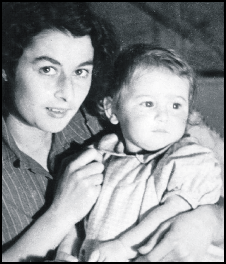
Violette and Tania at Vera Maidment's home, photographed by Vera's brother, Gordon.

Violette Reine Elizabeth Szabo GC
Violette left the battery in the February of ‘42 to return home to her ecstatic parents. She then found a flat at 36 Pembridge Villas in Notting Hill. Two of her friends, Carmen and Miriam, often stayed.
Étienne's letters stopped and without knowing what had happened to her husband, Violette went to St. Mary's Hospital, Paddington. On the 8th of June they were blessed with a daughter, Tania Damaris Désirée.
As a derivative of Titania, Queen of the Fairies, from Shakespeare's 'A Midsummer Night's Dream', it was in keeping with the royal name tradition of the Leroys Violette and Tania went to stay a few days with her very great friend, Vera Maidment, who lived with her mother at 59 Fernside Avenue, Mill Hill.
A few weeks of rest at the flat then followed. Violette wanted to get Tania somewhere safe from the bombing. She chose the area where she had spent her Land Army days, and took Tania to stay with a Mrs. Edwards, who ran a nursery for evacuated babies at Yew Lodge, near Havant.
During this time, Violette did not know that Étienne and his regiment were in retreat from Bir Hakim and were being regrouped and sent to reinforce the 8th Army in fighting Rommel's Forces.
There was news of fighting that involved his regiment, but no further information could be obtained from the Free French headquarters or the Red Cross.
Violette began working at the Rotax aircraft factory, where her father worked, in Morden. Some months later, she received news that meant Étienne would never set eyes on his daughter. He had died from battle wounds, to his chest, at El Alamein on October 27th.
Little did the poor grieving Violette know that her fate would take yet another crucial turn as a 'Mr. Potter' began trying to find her in the ATS.
His real name was Captain Selwyn Jepson - a former mystery writer - and he was recruiting people with various skills and languages for one of the most secret organisations of the War.
Once he had tracked her down, he invited Violette to attend an interview at the Ministry of Pensions at Sanctuary Buildings. Thinking it was something to do with Étienne's death, she duly attended.
Violette was told something of highly secret and dangerous work in France and 'Potter' discovered her fearlessness and determination. She was, in fact, being assessed for the F (French) Section of the Special Operations Executive.
Against the advice of some friends and unknown to her parents, Violette joined the SOE, as it was known, in July 1943. Violette became a Serving FANY in the First Aid Nursing Yeomanry, as was usual for female agents, on the 23rd of August. She organised her Will, brought Tania back from Havant and placed her in the care of Vera Maidment.
The SOE, was a top secret organisation created by Winston Churchill in order to place behind enemy lines a network of secret agents trained in clandestine warfare who would organise and co-ordinate covert resistance movements and destroy enemy communications and facilities.
A vital part of the F Section's task was to prevent German troops from supporting their coastal defences of France once the D-Day landings had begun.
The SOE commandeered many large houses in England and Scotland to accommodate and train a variety of nationalities in a range of disciplines according to the nature of their roles and missions.
Violette's personal file mentions her training at Winterfold, Knoydart, Ringway and at Blackbridge. She was sent to Winterfold, Surrey, in the August. It was the home of the Students Assessment Board where trainees were put through tests designed to determine their potential suitability as future agents and to highlight their strengths and weaknesses.
Her report mentions that she was " A quiet, physically tough, self willed girl. Has plenty of confidence in herself and gets on well with others. Plucky and persistent in her endeavours. Not easily rattled. She could possibly do a useful job as a courier."
The following month Violette was sent for commando training at Inverie House, Knoydart, in the West Highlands of Scotland. Here, agents received instruction in silent killing, fieldcraft, weapons training, sabotage and explosives. Violette's natural skills in firing came to the fore.
Her fearlessness, agility and toughness would have stood her in good stead during the physically gruelling exercises and survival training.
Parachute school at Ringway, near Manchester, then followed. Fatefully, during a practice jump she injured her left ankle and did not return to complete that part of her training until the end of the following February of 1944.
On the 17th October Violette went to Blackbridge, which was one of several 'finishing schools' on the Beaulieu estate in Hampshire. Here she would have received training in how to lead a clandestine life, maintain cover stories, contact other agents, avoid attracting attention, recognise enemy security forces and resist interrogation.
At Ringway, Violette had met Phillipe Liewer, (often known as Charles Staunton), and saw him again in London, with a colleague of his called Robert aloubier, (often known as Bob Mortier).
The head of F Section, Col. Maurice Buckmaster was preparing to send Staunton back to Rouen, where he was a wanted man. Therefore, someone was needed to check out the area on his behalf whilst he remained in Paris. He decided that he could trust Violette with his life and asked for her to join him.
Violette needed a new coding poem. Leo Marx, the Head of Codes, had written one (The Life That I Have) for a recently deceased girlfriend. He was so taken by Violette that he let it become hers. The poem has since become so synonymous with Violette's life that it forms the titles of the four information panels within the Violette Szabo GC Museum.
However, the mission was scrapped at the last minute because a message had come through saying that two agents and a transmitter had been captured by the Germans.
Violette was able to see more of Tania, and to get to know Staunton and Maloubier and another SOE colleague, Harry Peulevé, until the rescheduled take off for the evening of April 5th.
Seeing Harry must have been quite a shock because she had last met him at a night club several months before, believing him to be a Signals Officer on his way to North Africa. It is quite possible that following this initial meeting Peleuvé could have told the SOE about her.
Buckmaster saw Violette at SOE premises in Orchard Court just before she left London for her mission and recalled that she had "that wholly dedicated and admirable tension of the mind and senses which causes people to overcome fear and hardship when there is a rough job to do."
The F Section Intelligence Officer, Vera Atkins, travelled in the car which took Violette from London to Tempsford Airfield, near Bedford, that the SOE used. On the way, they passed Mill Hill. Seeing that Vera had noticed a change in her Violette explained "It's where my child is.
Violette’s new identity was that of Corinne Reine Leroy (based on her mother’s maiden name), a ‘secretaire commerciale’ from Le Havre - plus an emergency identity of Vicky Tailor( a play on her own name ) that could be used in Spain.
Now please buy the book from the museum..........
Web page content by Mike Colton, Secretary, Allied Special Forces Association, P.O. Box 32 Hereford HR1 9DF
